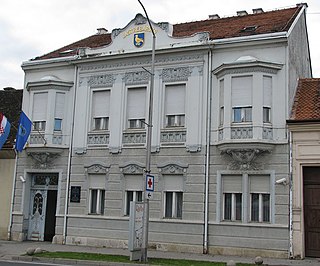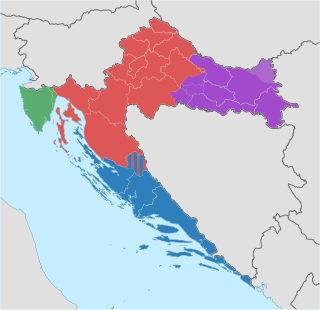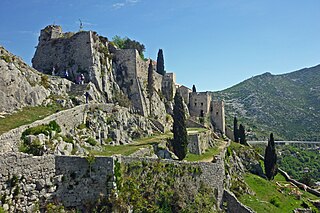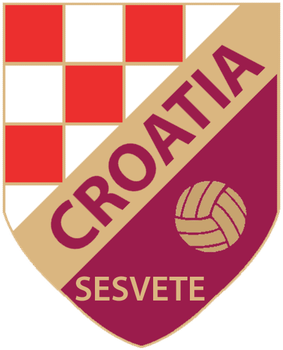
Zagreb is the capital and largest city of Croatia. It is in the north of the country, along the Sava river, at the southern slopes of the Medvednica mountain. Zagreb stands near the international border between Croatia and Slovenia at an elevation of approximately 158 m (518 ft) above sea level. At the 2021 census, the city itself had a population of 767,131, while the population of Zagreb metropolitan area is 1,086,528.

Medvednica is a mountain in central Croatia, just north of Zagreb, and marking the southern border of the historic region of Zagorje. The highest peak, at 1,035 m (3,396 ft) is Sljeme. Most of the area of Medvednica is a nature park, a type of preservation lesser than a national park. During Miocene and Pliocene, the mountain was an island within the Pannonian Sea.

Jastrebarsko, colloquially known as Jaska, is a town in Zagreb County, Croatia.

Though the Republic of Croatia administratively consists of twenty counties, it is traditionally divided into four historical and cultural regions: Croatia proper, Dalmatia, Istria, and Slavonia. These are further divided into other, smaller regions.

Moslavina, also known as Monoszló in Hungarian, is a microregion in Croatia centered on the central mountain of Moslavačka gora. It is administratively divided by the counties of Zagreb, Sisak-Moslavina and Bjelovar-Bilogora. The main city in the region in terms of traffic, commerce and business is the city of Kutina, with 24,000 citizens. Other important centres are Ivanić-Grad, Čazma, Garešnica and Popovača. Moslavina borders Banovina and Turopolje to the south-west, Kalničko Prigorje and Bilogora to the north and Slavonia to the east.

Klis is a Croatian village and a municipality located around a mountain fortress bearing the same name.

In contemporary geography, the terms Central Croatia and Mountainous Croatia are used to describe most of the area sometimes historically known as Croatia or Croatia proper, one of the four historical regions of the Republic of Croatia, together with Dalmatia, Istria, and Slavonia. It is located between Slavonia in the east, the Adriatic Sea in the west, and Dalmatia to the south. The region is not officially defined, and its borders and extent are described differently by various sources. The term Central Croatia refers to the northeastern part, and the term Mountainous Croatia refers to the southwestern part of the territory; the far western part is known as the Croatian Littoral; likewise the terms 'Zagreb macroregion' and 'Rijeka macroregion' can be used instead. Central Croatia is the most significant economic area of the country, contributing well over 50% of Croatia's gross domestic product. The capital of the Republic of Croatia, Zagreb, is the largest city and most important economic centre in Central Croatia.
The subdivisions of Croatia on the first level are the 20 counties and one city-county.

Brdovec is a municipality in the Zagreb County, Croatia. The closest town to Brdovec is neighboring Zaprešić on the east.

Dubravica is a municipality in Zagreb County, Croatia. According to the 2001 census, there are 1,586 inhabitants, absolute majority of which are Croats.
The history of Zagreb, the capital and largest city of Croatia, dates back to the Middle Ages. The Romans had built a settlement, Andautonia, in present-day Ščitarjevo. The name "Zagreb" was first used in 1094 at the founding of the Zagreb diocese in Kaptol, after the Slavs had arrived in the area. Zagreb became a free royal city in 1242. It was made the capital of Croatia in 1845 and elected its first mayor, Janko Kamauf, in 1851. According to the 2011 Croatian census, Zagreb had 792,875 inhabitants and was also Croatia's largest city by area.

Đurmanec is a village and a municipality in the Krapina-Zagorje County in Croatia.

NK Croatia Sesvete was a Croatian football club based in the Sesvete district of the City of Zagreb.

Prigorje Brdovečko is a village in Croatia. It is connected by the D225 highway.
Vjekoslav Servatzy was a Croatian Ustaše military officer and nationalist politician, executed for war crimes in 1945.

Posavina is a geographical region that stretches along the Sava river, encompassing only the inner areas of the Sava river basin, that are adjacent or near to the Sava river itself, namely catch region spanning from the Julian Alps in the northwest to the confluence with the Danube in the southeast. It passes through several countries of former Yugoslavia, namely Slovenia, Croatia, Bosnia and Herzegovina and Serbia. In Slovene, the term Posavina is not used to describe the parts of Slovenia that lie by the Sava river. Instead, the terms Posavje, Zasavje and Zgornjesavska dolina are used.
Hrvatski nogometni klub Hajduk Split is a Croatian association football club based in Split, which currently competes in the top tier division of Croatian football, Prva HNL. Founded in 1911, they played only friendlies during their first years in existence. Between the early 1920s and 1940, Hajduk regularly participated in the Kingdom of Yugoslavia national championship. The club spent their entire existence playing top-flight football, having been a member of Yugoslav First League from 1946 until its dissolution in 1991. Following the breakup of Yugoslavia the club joined the Croatian First League in its inaugural season in 1992.
Prigorje is a geographical subdivision of Croatia.
Vatroslav Rožić was a Croatian linguist and ethnographer.
Ivan Crkvenčić was a prominent Croatian food and regional geographer as well as geopolitician.













